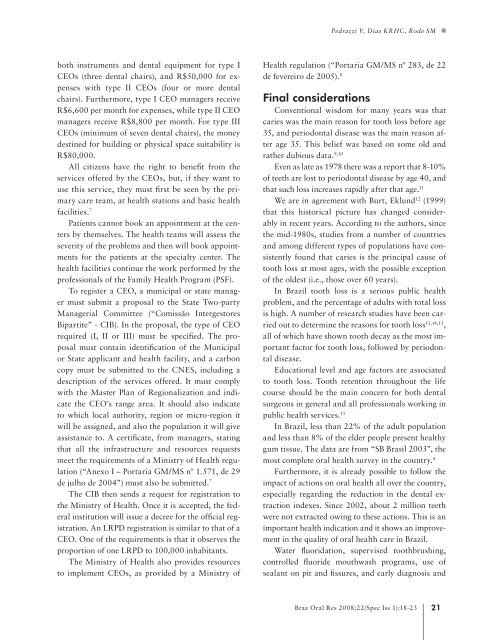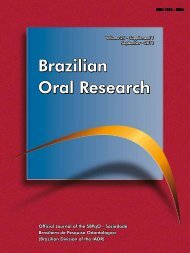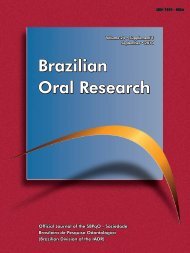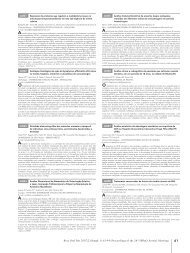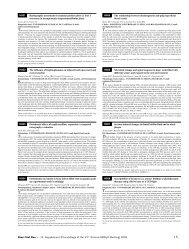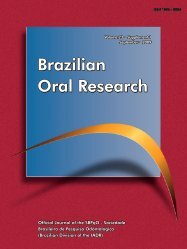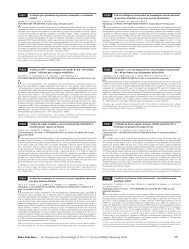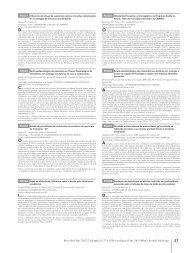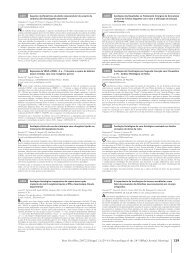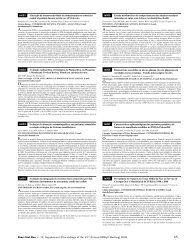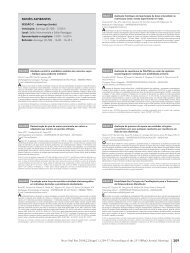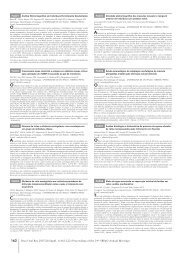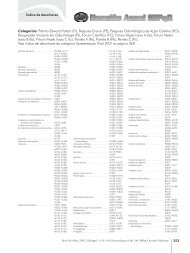Brazilian Oral Research Brazilian Oral Research Brazilian Oral
Brazilian Oral Research Brazilian Oral Research Brazilian Oral
Brazilian Oral Research Brazilian Oral Research Brazilian Oral
You also want an ePaper? Increase the reach of your titles
YUMPU automatically turns print PDFs into web optimized ePapers that Google loves.
oth instruments and dental equipment for type I<br />
CEOs (three dental chairs), and R$50,000 for expenses<br />
with type II CEOs (four or more dental<br />
chairs). Furthermore, type I CEO managers receive<br />
R$6,600 per month for expenses, while type II CEO<br />
managers receive R$8,800 per month. For type III<br />
CEOs (minimum of seven dental chairs), the money<br />
destined for building or physical space suitability is<br />
R$80,000.<br />
All citizens have the right to benefit from the<br />
services offered by the CEOs, but, if they want to<br />
use this service, they must first be seen by the primary<br />
care team, at health stations and basic health<br />
facilities. 7<br />
Patients cannot book an appointment at the centers<br />
by themselves. The health teams will assess the<br />
severity of the problems and then will book appointments<br />
for the patients at the specialty center. The<br />
health facilities continue the work performed by the<br />
professionals of the Family Health Program (PSF).<br />
To register a CEO, a municipal or state manager<br />
must submit a proposal to the State Two-party<br />
Managerial Committee (“Comissão Intergestores<br />
Bipartite” - CIB). In the proposal, the type of CEO<br />
required (I, II or III) must be specified. The proposal<br />
must contain identification of the Municipal<br />
or State applicant and health facility, and a carbon<br />
copy must be submitted to the CNES, including a<br />
description of the services offered. It must comply<br />
with the Master Plan of Regionalization and indicate<br />
the CEO’s range area. It should also indicate<br />
to which local authority, region or micro-region it<br />
will be assigned, and also the population it will give<br />
assistance to. A certificate, from managers, stating<br />
that all the infrastructure and resources requests<br />
meet the requirements of a Ministry of Health regulation<br />
(“Anexo I – Portaria GM/MS nº 1.571, de 29<br />
de julho de 2004”) must also be submitted. 7<br />
The CIB then sends a request for registration to<br />
the Ministry of Health. Once it is accepted, the federal<br />
institution will issue a decree for the official registration.<br />
An LRPD registration is similar to that of a<br />
CEO. One of the requirements is that it observes the<br />
proportion of one LRPD to 100,000 inhabitants.<br />
The Ministry of Health also provides resources<br />
to implement CEOs, as provided by a Ministry of<br />
Pedrazzi V, Dias KRHC, Rode SM<br />
Health regulation (“Portaria GM/MS nº 283, de 22<br />
de fevereiro de 2005). 8<br />
Final considerations<br />
Conventional wisdom for many years was that<br />
caries was the main reason for tooth loss before age<br />
35, and periodontal disease was the main reason after<br />
age 35. This belief was based on some old and<br />
rather dubious data. 9,10<br />
Even as late as 1978 there was a report that 8-10%<br />
of teeth are lost to periodontal disease by age 40, and<br />
that such loss increases rapidly after that age. 11<br />
We are in agreement with Burt, Eklund 12 (1999)<br />
that this historical picture has changed considerably<br />
in recent years. According to the authors, since<br />
the mid-1980s, studies from a number of countries<br />
and among different types of populations have consistently<br />
found that caries is the principal cause of<br />
tooth loss at most ages, with the possible exception<br />
of the oldest (i.e., those over 60 years).<br />
In Brazil tooth loss is a serious public health<br />
problem, and the percentage of adults with total loss<br />
is high. A number of research studies have been carried<br />
out to determine the reasons for tooth loss 13,14,15 ,<br />
all of which have shown tooth decay as the most important<br />
factor for tooth loss, followed by periodontal<br />
disease.<br />
Educational level and age factors are associated<br />
to tooth loss. Tooth retention throughout the life<br />
course should be the main concern for both dental<br />
surgeons in general and all professionals working in<br />
public health services. 15<br />
In Brazil, less than 22% of the adult population<br />
and less than 8% of the elder people present healthy<br />
gum tissue. The data are from “SB Brasil 2003”, the<br />
most complete oral health survey in the country. 4<br />
Furthermore, it is already possible to follow the<br />
impact of actions on oral health all over the country,<br />
especially regarding the reduction in the dental extraction<br />
indexes. Since 2002, about 2 million teeth<br />
were not extracted owing to these actions. This is an<br />
important health indication and it shows an improvement<br />
in the quality of oral health care in Brazil.<br />
Water fluoridation, supervised toothbrushing,<br />
controlled fluoride mouthwash programs, use of<br />
sealant on pit and fissures, and early diagnosis and<br />
Braz <strong>Oral</strong> Res 2008;22(Spec Iss 1):18-23 21


